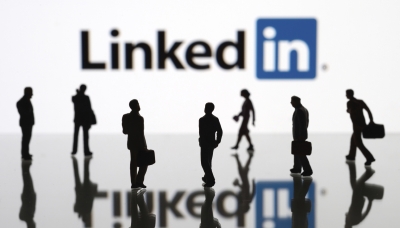
by Fronetics | Mar 24, 2016 | Blog, Marketing, Social Media, Supply Chain

These four supply chain companies constantly post fresh, quality content to their social media accounts.
When it excels at social media, a company’s opportunity for growth is as vast as the web itself. Today, even small businesses can compete shoulder to shoulder with their biggest competitors if leveraging social media properly.
It is estimated that for every 5 minutes people spend online, 1 minute of that is spent on some kind of social media network. And most of your customers are on social media — statistics indicate that more than 79% of adults in the U.S. use social media each day. As the popularity of sites like Facebook, Twitter, Instagram, and company blogs continues to grow, it is vital to utilize these tools to your own marketing advantage.
When you think of social media masters, you may not think of companies in the supply chain industry. But there are a few excellent examples, and much can be learned from what they do. Here are four supply chain companies that excel at social media and the reasons why they stand out above the crowd:
1) Cerasis
Cerasis, a top freight logistics company and truckload freight broker, excels at social media because their content is fresh, posted daily, and of high quality. Simply put, they create engaging, informative content and are consistently active across all of the major social networks.
2) Kinaxis
Kinaxis, a global company offering advanced supply chain management systems to customers in a variety of discrete manufacturing industries, offers in-depth blog posts and is consistently active in social media channels such as Twitter, Google+, and LinkedIn.
3) Transplace
Transplace, a provider of transportation management services, posts informative articles and incites topics of conversation on Twitter several times per day. The company is active across all social media platforms, including their own YouTube channel.
4) UPS Longitudes
Longitudes is a blog with insights on the trends reshaping the global economy by United Parcel Service, a global leader in shipping. The blog also engages true thought leaders on topics ranging from trade to transportation and ecommerce to emerging markets. Posts are consistently new, innovative, and informative. Longitudes also has its own social media accounts, separate from UPS’s primary accounts, which distribute the blog’s content and engage in related discussions.
Why do these four supply chain companies excel at social media? Here are three commonalities that help these businesses rise above the rest:
Consistent daily posts and content
Having consistent, reliable, fresh social media posts is essential. The more active you are, the greater your outreach to potential new customers.
Think of it this way: search engines pick up on social media activities — like when someone shares content from your website on Twitter or Facebook, for example. Search engines use this to weigh the relevancy and validity of your website and your company. So, fresh daily or weekly content gives people a chance to read and share every time you publish a blog post, ebook, buying guide, case study, testimonial, and other interesting content to your social media accounts. Your marketing efforts reap the benefits of better search engine rankings as a result.
Engaging readers
You want readers to connect and engage with your social media posts. Every time they leave a comment or share or like a post, your social media presence — and your digital footprint — grows.
Quality content
Posting anything just for the sake of posting is not a good social media strategy. Content that is boring and basic will not help your business grow. Content needs to capture the interest of readers and engage them to read, share, and follow your business. Posts should be timely and relevant. This is what builds your following and your brand and generates new customers.
With social media you can find new customers and fans, connect with existing customers who can help spread the word about how great your product or service is, and drive more traffic to your website, which creates new avenues into the digital realm of marketing, company branding, and lead generation. The most successful companies today work daily to improve their social media content and reap the benefits of consistent, quality content marketing.
Related posts:

by Fronetics | Feb 15, 2016 | Blog, Marketing, Social Media, Strategy

When you are posting on social media could be as important as what you’re posting.
Timing is everything, and that statement especially holds true when it comes to posting content to social media. If you are sending out your message and nobody is there to see it, you are that proverbial tree falling in the forest; you did not make a sound. Your post had little to no impact.
So, even if you are putting in the time and effort to craft informative blog posts, tweets with just the right message, or Facebook posts that inspire more than just page likes, you still are not getting the most exposure you can out of social media.
Data that delivers results
According to research by social media scientist Dan Zarrella, when you are posting your content can be almost as important as what you are posting. Luckily, there is an ample amount of analytical data out there regarding optimal times to post on Facebook, Twitter, LinkedIn, Pinterest, and Instagram.
For example, looking at broad-based Twitter engagement, research suggests that users go up by 30 percent on weekends, speculatively because more people are on their computers, smartphones, and tablets during their free time. On weekdays, this peaks at 4 p.m. EST, perhaps as people check into social media as the workday begins to wind down and they are seeking a diversion.
Some studies suggest that Twitter use often peaks slightly earlier, between 1 and 3 p.m. on weekdays, and this might be attributed to people who take an extended lunch break.
LinkedIn studies show that the optimum times to post content are Tuesday through to Thursday during normal work hours. Also noted: Tuesday 10 to 11 a.m. is known to get the most clicks and shares.
When it comes to Facebook, another marketing study suggests that there is quite a wide range of variables, and it is really based upon your audience. But, in general, the best time to post on Facebook is 3 p.m. on Wednesday. Other popular times include 1 to 4 p.m. on Thursdays and Fridays, and lunchtime (12 to 1 p.m.) on weekends.
There are poor times to post on Facebook, too, such as weekends before 8 a.m. and after 8 p.m., according to SurePayroll’s research.
Research supports that B2B content generally performs 16% better during typical business hours, while B2C content performs 17% better on weekends.
Your (personal) optimal posting time
But, the problem with these suggestions is that they are just statistical generalizations of when might be the optimal time for posting content. What you need is analytics that are specific to your particular followers. Your audience maybe a different demographic than those represented in these studies, and when they are reading, sharing, or retweeting may actually surprise you.
You can access personalized data regarding the social media habits of your readers and followers through analytic programs like Google Analytics and sites like Tweriod. There are a wealth of available free tools, which provide valuable insight regarding your audience.
Here are a few to consider:
- Tweriod is a free Twitter tool that helps you know the best time to tweet. The free analysis will analyze up to 1000 of your followers. Tweriod is not part of Twitter but rather is something you may access to better understand your followers’ schedules and interests, like what they have retweeted.
- Followerwonk can help you to individuate your potential Twitter audience by learning not only who follows your competitors, but who commonly retweets their content. You can also look at your own personal audience and discover what content they like, share, and maybe even link to from other posts, as well as when they are most active on social media.
- Facebook Insights tells you the best times and days to post content by accessing your page’s insights in the posts sections. In the graph section for “When Your Fans Are Online,” you can see the days and times when your fans are using Facebook. This data is constantly updated.
- Google Analytics provides insights, analytics, and data regarding your website, and it lets you do more than measure sales and conversions. It also gives insights into how visitors find and use your site, what they are clicking on, and how to keep them coming back.
Many people still play a guessing game when it comes to deciding the best time to post their content for the most impact. But, studies suggest the average life of a tweet is only about 18 minutes. So, if you tweet something during an inactive period for your Twitter audience, you are probably wasting your time.
Posting the right content, at the right time, can make the difference between getting valuable comments, shares, and clicks on your links, and it can provide a myriad of valuable new leads.
Related posts:

by Fronetics | Nov 2, 2015 | Blog, Marketing, Social Media, Strategy

In mid-October, LinkedIn made some big changes: LinkedIn Groups are private and there’s a new, standalone LinkedIn Groups app for iOS users. Many LinkedIn Groups were used for the purpose of networking, research, and prospecting, however many people were misusing, and even abusing, the Group option. Rather than using groups properly, to form relationships, engage with industries that could supplement yours, and keep up with hot topics, the group option was often used for self-promotion.
The Changes
According to LinkedIn, these changes were spurred by consumer feedback. “Our research has shown that professional conversations are most effective in a private trusted space, so conversations in groups won’t be visible until you’ve joined the group. Joining a LinkedIn group now requires either an invitation or approval of your request. Our data has shown that open groups have historically attracted a larger percentage of low-quality conversations. Members-only groups have created significantly more participation and conversations than others (up to five times more), indicating that members feel more confident contributing in these types of groups.”
Some additional, prominent changes:
- Moderation: Conversations will be posted without the need for approval from a moderator, manager, or group owner, however those people can still remove off-topic conversations.
- Standard and Unlisted Groups: In an effort to simplify things for the consumer, groups will be either unlisted, meaning that they don’t show up in search results and only a manager/moderator can invite people members, or standard, meaning that groups do show up in search results and members can invite anyone with a 1st degree connection.
- Content Filtering: Filtering of spam and low-quality content to keep promotional material out of conversations.
- Subgroups: Subgroups will no longer exist to help clear up confusion. Any current subgroups will become their own, standalone groups.
- Mentions in Conversations: Like other forms of social media, the @ symbol will now be used before a name in order to reference someone and bring them into the conversation.
Other changes can be found at LinkedIn’s Help Center page.
Group Etiquette
If you’re already using groups in smart way, you’ll only see improvement from LinkedIn’s changes. Say goodbye to spam and relentless self-promotion. Groups may become more meaningful with a more exclusive approach. The people who are genuinely interested in having specific, topical conversations will. Here are some tips on how to navigate the new Groups:
-
Engage Don’t Enrage:
Keeping in mind that there’s a difference between narcissism and seeking feedback, wait a bit before you post your own blogs, articles, or other branded content. You may want a group of talented, knowledge people to review your writing, but you need to establish yourself as a valued member of the group first. Comment on and like others’ posts. Put in your time and build rapport.
-
Prudence in Posting:
When there’s a discussing going about a topic that speaks to you, you might feel anxious to jump in with a relevant article you’ve written, but consider your timing. Only after posting third-party articles and blogs, to show your support of others and breadth of knowledge, consider posting your own. When you do post your first article, it might be helpful to connect it to the groups’ influence. For example, Based on the recent, rich conversation about the engagement of Boomers and Millennials in the workplace, I gather my recent years of experience with this and wrote an article I though I’d share with you. I appreciate the fruitful conversations here that helped spur this article.
-
Connect Cautiously:
As with all etiquette, the idea isn’t to approach people with fear, but with respect. Sometimes, early on, respect can be established by being cautious in order to better understand individual and community needs and norms. Once you’re in a group, don’t be unknowingly creepy. Engage with people who might have similar interests or who you feel might be attracted to your brand. First comment on their posts, like an article, show that you’re engaged and have something to offer intellectually. Give them your thoughts before your products. Once some sort of engagement is established, then send a connection request.
The new changes to LinkedIn’s Group option is going to serve everyone well, whether you’re in marketing in or any other field. It means more meaningful engagement and less bothersome noise and chatter.
Fronetics Strategic Advisors is a leading management consulting firm. Our firm works with companies to identify and execute strategies for growth and value creation.
Whether it is a wholesale food distributor seeking guidance on how to define and execute corporate strategy; a telematics firm needing high quality content on a consistent basis; a real estate firm looking for a marketing partner; or a supply chain firm in need of interim management, our clients rely on Fronetics to help them navigate through critical junctures, meet their toughest challenges, and take advantage of opportunities. We deliver high-impact results.
We advise and work with companies on their most critical issues and opportunities: strategy, marketing, organization, talent acquisition, performance management, and M&A support.

by Fronetics | Aug 13, 2015 | Blog, Marketing, Social Media, Strategy
 With LinkedIn this month reporting a 33% year-over-year growth of revenue and a 21% increase in membership, it remains solid in its role as the primary social network for business. Data from outside the company confirm its dominance. A University of Massachusetts study published earlier this year examined social media use by the fastest-growing corporations in the U.S. and found that LinkedIn is the platform of choice (94%) for America’s top companies. There’s little doubt that the 380 million member social media giant has transformed the relationship between companies, its customers, and its employees. But with so many potential connections and opportunities for engagement, how can your company squeeze the most out of its efforts to connect with audiences on LinkedIn? Look to your employees.
With LinkedIn this month reporting a 33% year-over-year growth of revenue and a 21% increase in membership, it remains solid in its role as the primary social network for business. Data from outside the company confirm its dominance. A University of Massachusetts study published earlier this year examined social media use by the fastest-growing corporations in the U.S. and found that LinkedIn is the platform of choice (94%) for America’s top companies. There’s little doubt that the 380 million member social media giant has transformed the relationship between companies, its customers, and its employees. But with so many potential connections and opportunities for engagement, how can your company squeeze the most out of its efforts to connect with audiences on LinkedIn? Look to your employees.
Consider this case study in “smart ownership”. Aiming to increase the popularity of its Instagram account, the dedicated social media team at National Public Radio (NPR) did something unheard of – they turned ownership of its Instagram account over to its multimedia team. The team reasoned that aligning the organization’s visual strategy with a digital medium that’s innately visual could be the key to deriving the most value from the social network. In short, NPR recognized the value of extending ownership of its social media efforts to its employees.
Here’s why your business should leverage the popularity of LinkedIn and develop its own smart ownership strategy:
Broadening inclusion of your company’s LinkedIn efforts beyond a sole person or dedicated social media team lets employees share ownership of your brand. A strategy informed, directed, and executed by a single team or person can sometimes be narrow in scope. Encouraging the participation of your employees expands perspective and gives your in-house subject matter experts a digital voice – one that might connect beautifully with your leads and prospects.
Encouraging your employees to engage with your company on LinkedIn helps your brand reach new audiences. Your company benefits in a number of ways when an employee connects with it on LinkedIn. When a new employee adds his new work experience to his profile, your company’s logo is displayed on his profile for each of his connections to see. When an employee likes, shares, or comments on the content published by your business, a notification is generated and seen by his connections. These seemingly routine updates or tasks, like personal LinkedIn profile updates, can turn into real opportunities to reach an expansive audience.
Engaging employees on LinkedIn creates trust and substantiates professional relationships. Several years ago, faced with the rapid emergence of social media, many employers chose to ban social media sites from company networks thinking that if they could prohibit the use of these sites during work hours, employees would be more attentive to their work and thus more productive. What we know now, is that these types of strategies stymy growth and propagate missed opportunities. The author of a 2013 study examining the link between social media and worker productivity has this to say: “… the ubiquitous digital connectivity altered workers’ sense of ‘presence’ and helped rather than hindered the effective completion of collective tasks.” The message here is two-fold: encouraging employee use of LinkedIn builds trust and increases productivity.
Promoting LinkedIn as a company-endorsed channel of distribution builds positive branding and marketing opportunities. Quite simply, who better to promote the work of your company than the employees who carry out the day-to-day responsibilities? And because people are far more likely to interact with individuals over brands, your company’s promotion by your employees is likely to drive more engagement.
Communicating with employees via LinkedIn can take your social efforts beyond marketing. While it’s true that most businesses use social media to ultimately affect their bottom line, not all social media efforts need to be strictly marketing. A robust LinkedIn community of employees can serve to both improve employer-employee communications and enhance the distribution of public information. Need to get your messaging out quickly? Use your employee base on LinkedIn to help distribute timely messaging or to clarify your company’s position on an emerging matter.
Building a successful smart ownership strategy isn’t about giving away ownership, but about building inclusion and better aligning existing resources. Businesses that encourage employee engagement on LinkedIn are well-positioned to build brand ambassadors out of those who know their business most intimately.
Fronetics Strategic Advisors is a leading management consulting firm. Our firm works with companies to identify and execute strategies for growth and value creation.
Whether it is a wholesale food distributor seeking guidance on how to define and execute corporate strategy; a telematics firm needing high quality content on a consistent basis; a real estate firm looking for a marketing partner; or a supply chain firm in need of interim management, our clients rely on Fronetics to help them navigate through critical junctures, meet their toughest challenges, and take advantage of opportunities. We deliver high-impact results.
We advise and work with companies on their most critical issues and opportunities: strategy, marketing, organization, talent acquisition, performance management, and M&A support.
We have deep expertise and a proven track record in a broad range of industries including: supply chain, real estate, software, and logistics.


by Fronetics | Jul 7, 2015 | Blog, Marketing, Social Media, Strategy
With LinkedIn claiming the top spot for social networking professionals, there’s a good chance you already access the social network regularly. But what you might be missing on LinkedIn could be the key to unlocking more business opportunities.
Allow me to explain. There’s been a lot of talk about the impact social media is having on business sales. And for good reason – last year, the total amount of sales that could be tracked to social networks hit $3.30 billion, up 26% from 2013’s $2.62 billion. A growing number of companies are realizing there’s more opportunity than ever to use social platforms as lead generation and prospecting tools. When it comes to LinkedIn, reports suggest that users who command a deeper understanding of the social network’s capabilities reap far greater benefits than those that still view LinkedIn primarily as a job search tool.
One of LinkedIn’s best features for driving new business leads and opportunities is LinkedIn Groups. LinkedIn describes their Group feature as a “place for professionals in the same industry or with similar interests to share content, find answers, post and view jobs, make business contacts, and establish themselves as industry experts.” Essentially, it’s an online community where you can connect with industry peers and like-minded professionals (read: prospects and leads).
Never tried Groups before? Here’s a quick guide to get you up and running so you can start prospecting and finding leads today. As a prerequisite, you should already have an active LinkedIn account. If you don’t, start here.
Find Groups
To start, let’s take Groups out for a spin. From the homepage, navigate to the search bar at the top and click on the tab directly to the left on it. Drag down to “Groups”, then, type in a subject you’re interested in (e.g., marketing, sales, baking, etc.). You might notice that when you do a search, LinkedIn also provides suggestions not only on “Groups” but in several other categories such as “Connections,” “Companies,” “Features” and “Skills.” Once you’ve used your keyword to narrow your search, find a group that best matches what you’re looking for.
Cast a Wide Net
Once you’ve selected your group, join it. You may have to request membership approval if it is a private group. While there’s no limit to the amount of groups you can join, the sweet spot for lead generation is to join groups that are outside your industry or function that might help you grow your business. If you’re a small (and growing) 3PL, for example, don’t just industry groups, expand your network by joining groups for entrepreneurs and small business owners.
Commit to Building Your Network
Set aside some time each week to connect with five current or former business colleagues. LinkedIn makes it easy by providing suggestions based on your current connections and places of employment. More connections equal more opportunities for discussion about your company’s products and services.
Answer like a Pro
Use the Answers section within your groups as a place to showcase your expertise. Set a goal to answer at least two questions per week. After actively participating in a group for at least two weeks, start your own discussion within the group. Engaging industry peers in a rich dialogue is a great way to build trust and confidence among members of your new group. Turning your question and answering activity into leads is a long-term strategy, but one that can prove successful as people will begin to look at you as an expert and leader in your industry.
Practice Consistency
The key to generating leads via LinkedIn is consistency. Steady participation in your groups is the secret is to building relationships that will pay off in the end. Take some time to determine what’s working in your strategy and refocus your efforts as necessary, but always, always be consistent in your participation. In the end, it’s your activity that is going to set you apart from the competition and establish your expertise.
In a recent survey of sales professionals, most reported they were unfamiliar with LinkedIn’s full capabilities, but in the same survey, a little more than a third of respondents reported generating new business opportunities and revenue gains from their use of LinkedIn. It’s clear that the social network holds opportunity for those that recognize – and leverage – the network’s full capabilities.
Fronetics Strategic Advisors is a leading management consulting firm. Our firm works with companies to identify and execute strategies for growth and value creation.
Whether it is a wholesale food distributor seeking guidance on how to define and execute corporate strategy; a telematics firm needing high quality content on a consistent basis; a real estate firm looking for a marketing partner; or a supply chain firm in need of interim management, our clients rely on Fronetics to help them navigate through critical junctures, meet their toughest challenges, and take advantage of opportunities. We deliver high-impact results.
We advise and work with companies on their most critical issues and opportunities: strategy, marketing, organization, talent acquisition, performance management, and M&A support.
We have deep expertise and a proven track record in a broad range of industries including: supply chain, real estate, software, and logistics.









